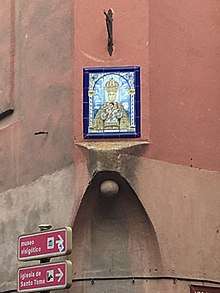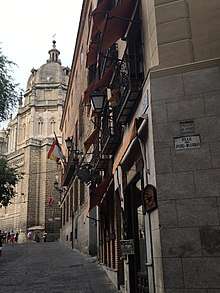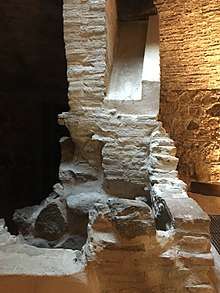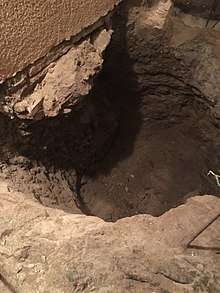Wells of Toledo

In Toledo, Spain before the standardization of modern plumbing, there were two common ways to get water for one's daily needs. First, there was the Tagus river that runs next to the city, and second there were water wells (also called pozos in Spanish) and water reservoirs (called aljibes in Spanish) that were built inside city plazas and individual houses. Although today the people of Toledo get their water from faucets, the wells and water reservoirs still exist, almost forgotten in the corners and basements of older houses in Toledo. A hidden indication that one can see in the streets of Toledo are the small stone balls or "bolas" in the outside corners of buildings. A family would put this small stone ball in the corner of their house so that their neighbors would know in case of a fire that they had a well or water reservoir inside.[1] Also, at times one can find the places that had (or still have) a communal well by looking at the names of the streets. A quick search of a map of Toledo and its neighborhoods reveals these streets: Calle del Pozo Amargo, Calle Pozo de las Nieves, Calle Pozo de Dos Bocas, Calle del Pozo Olías, Calle Pozos, Calle del Pozo Nuevo, Calle Pozo del Guindo, and the Calle del Pozo Ayuso. Although the wells and water reservoirs are not the most popular places to visit for tourists or locals, their histories and legends contribute to the distinct culture that exists in Toledo.
Legends
The Bitter Well

There are various versions of this story, but the essence of the legend goes like this: There was a Christian man, Fernando, and a Jewish woman, Raquel, the daughter of Samuel ha-Levi, that were head-over-heels in love with each other.[2] Every night when the church bells rang ten, Fernando would jump over the walls of Raquel's family garden and sit with his love on the edge of the well. But one night, the father of Raquel found out about the forbidden love of his daughter and the next night he sent an assassin to murder Fernando. Every night afterwards the heartbroken Raquel would sit where she used to with her lover, while her tears flowed into that sad well. One night, Raquel saw the image of her love in the water and so she jumped inside the well to be with him.[3] Today, there is a plaque in the plaza of that legendary well that reads, "Las lágrimas que el recuerdo, añoranza del amado causaron en una joven toledana, amargaron las aguas de este pozo”. (The tears of the memory, longing for the beloved caused in a young Toledan girl, makes the waters of this well bitter.)
The water of the Virgen
A popular idea in Toledo is that many of the cathedrals and churches have some type of running water underground, many of which are said to be sacred or miraculous.[4] A legend in particular tells the miracle of the water of the Virgen that took place in the Toledo Cathedral. Since the seventeenth century, this cathedral has celebrated the day of Our Sacred Lady, patron of Toledo, on the fifteenth of August, a date during the hottest part of the summer. One year, while all of the people were observing the holiday outside of the cathedral (on account of the heat inside) a young man overheated and fainted, and seemed to be dead. Some people brought water from the wells inside the cathedral in order to reanimate him, and he was revived! The people said this was a miracle, done by the Virgen whom they were celebrating. Additionally, with the same wells, there is a story that during the Reconquista the image of the Virgen was kept safe from the invasion inside a church well. .[5]
Well-Known Wells in Toledo
The Arabic Well
Not a physical well, but a painting of a Toledan well with an Arabic girl, painted by Valeriano Bécquer.
The Well of Salvador

This well now is below a beautiful plaza, but originally it was below a convent of the El Salvador church. This well has a water reservoir that gathers and saves water from the rain, this mechanism used to collect water can be seen in the picture. There is also a regular well that brings water from the earth.
The water reservoir of Alcázar
This water reservoir provided some water to the francoists during the siege of the Alcázar of Toledo. Now, one can see the great size of the water reservoir.[7] An informative plaque in the Army Museum of Toledo says that an official of the King of Spain in the year 1550 liked the water reservoir so much that he said that the water reservoir provides water, "muy buena y muy fresca" (very good and very fresh).[8]
Wells of the Toledan Baths

There are various Roman baths and Arabic baths that one can see in Toledo. All of these baths have a well, the majority of which are dry now, in order to provide water to the baths. The photo to the right is of the well of an Arabic bath that is named caballel. Normally there were three rooms to bathe in within the baths: one with hot water, one with lukewarm water, and finally one with cold water. There are also the ruins of the Roman baths that one can visit, and a bath under a house in la judería.
References
- ↑ "7 curiosidades que no sabías de las calles de Toledo" (in Español). Online. 28 July 2015. Retrieved 28 June 2017.
- ↑ Reid, Irene (2016). Strolling Around Toledo. Kindle Edition.
- ↑ Oliva, Juan Luis Alonso (2013). Navegando por las leyendas de Toledo (Web ed.).
- ↑ Bausa, Luis Rodríguez (20 June 2017). Toledo insólito. Rutas de Toledo.
- ↑ Oliva, Juan Luis Alonso (14 August 2016). Leyendas de Toleda (Online ed.). pp. El Agua de la Virgen.
- ↑ "Rutas De Toledo". Ruta Toledo Subterráneo. 20 June 2017.
- ↑ Pablete (1 January 1970). "Aljibe del Alcázar de Toledo" (in Español) (Online ed.). Missing or empty
|url=(help);|access-date=requires|url=(help) - ↑ Txt on the wall. "Tank". Museo del ejército, Toledo.

